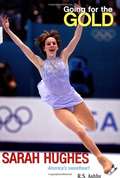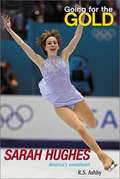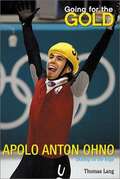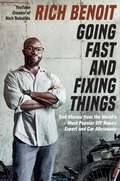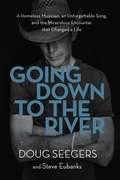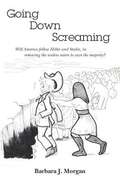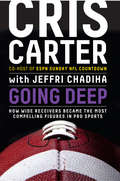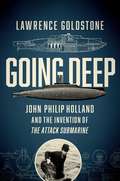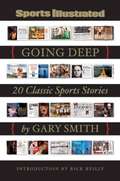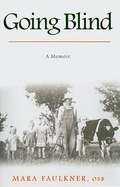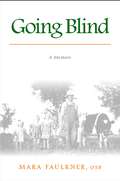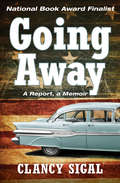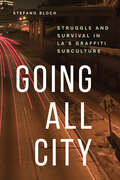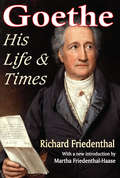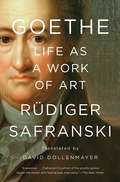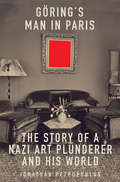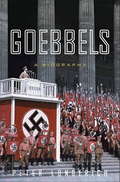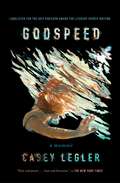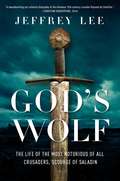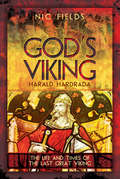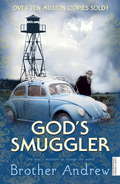- Table View
- List View
Going for the Gold: Sarah Hughes
by R. S. AshbyIce Princess Sarah Hughes was born to skate, and she proved to the world with her dramatic gold medal victory at the 2002 Winter Olympics. But the road to Olympic glory was not always easy for this Long Island teen. Going for the Gold: Sarah Hughes is the amazing true story of a brilliant skater's Olympic quest. Here's what you'll find out about America's newest sweetheart: Sarah's first time on the ice How her family's support helped her through difficult times How Sarah braved the rocky road to the Olympics Sarah's hopes for the future
Going for the Gold: Sarah Hughes
by Ruth AshbyThis book is about American superstar Sarah Hughes, who skated in the 2002 Winter Olympics.
Going for the Gold: Apolo Anton Ohno
by Thomas LangOhno was born to an American mother, Jerrie Lee, and Japanese-born father, Yuki Ohno. The story of Ohno's family and his quest for Olympic gold.
Going For Gold: Welsh Olympic Dreams for 2012
by Lynn DaviesWhat does it take to be the greatest? Whether it's part of a team like cyclist Geraint Thomas, who won gold in the team pursuit event in Beijing 2008, or notching up a record-beating 11 gold medals in the swimming pool for paralympic swimmer David Roberts to equal the record set by Dame Tanni Grey Thompson, the athletes featured in Going For Gold have one aim - to win. This collection of stories from Wales's top current and future athletes will inspire others to follow their goals. Foreword by Olympic gold medallist Lynn Davies CBE, President of UK Athletics Featuring Dai Greene, David Roberts, Geraint Thomas, Jazz Carlin and Nathan Stephens.
Going Fast and Fixing Things: True Stories from the World's Most Popular DIY Repair Expert and Car Aficionado
by Rich BenoitRich Benoit went from buying a left-for-dead Tesla to becoming a successful YouTube entrepreneur and launching The Electrified Garage, the nation&’s first successful EV-only business devoted to repairing Teslas and other electric vehicles. Today he is the world&’s most popular DIY expert and car aficionado, and now he shares his story and expertise. People are fascinated by Tesla: the cars, the stock price, and especially its headline-grabbing CEO. Rich Benoit was the first YouTuber to pull back the curtain on the cultlike business model that is the Tesla company, and he&’s personally battled its consumer-unfriendly business practices. In Going Fast and Fixing Things, Rich provides readers with behind-the-scenes access not only to his Rich Rebuilds YouTube channel but to his off-camera life as well. Throughout his life, Rich has almost always been the proverbial &“only Black guy in the room,&” but despite the fact that online car culture—especially electric vehicle fandom—skews overwhelmingly white, he has become the most popular car rebuilding guy on the internet. His voice on the page is funny and intimate and a little goofy—just like his video persona—but always tempered by a clear determination to create success for himself as well as for his fans. Going Fast and Fixing Things also includes tips to help readers fix, drive, and buy their own cars, along with advice on how to defy the disposable-is-better consumerist ethos that saturates our current culture.
Going Down to the River: A Homeless Musician, an Unforgettable Song, and the Miraculous Encounter that Changed a Life
by Doug Seegers Steve EubanksThe astonishing story of a singer-songwriter living on the streets of Nashville who met Jesus, got sober, and found international stardom at the age of 62.Doug Seegers left New York for Nashville in search of every songwriter’s dream. When he didn’t find success, he fell into a state of loneliness that fed an addiction he had battled since adolescence. Soon, he was homeless, playing his guitar on the street with a cardboard sign asking for money. But then he cried out to God in repentance and need, and God graciously met him. Doug then found sobriety, regained some footing, and in a miraculous moment was discovered outside a food pantry by a Swedish musician and documentarian who put his story on the air in Stockholm. Within days of the documentary airing--even though he still walked to the public library every day and acquired most of his belongings from nearby Dumpsters--Doug had the number-one selling song in Sweden. Going Down to the River is Doug’s inspirational story of faith, forgiveness, and the power of prayer and belief. It is also the never-give-up tale of a man who played music for 55 years without success only to become a chart-topping artist at the age of 62.
Going Down Screaming: Will America Follow Hitler and Stalin, In Removing the Useless Eaters To Save The Majority?
by Barbara J. MorganA history of the nursing home industry, coupled by a short history of the school system. There two events are the crux of the story describing the elderlly and their values, the young and their lack of values. Subsequently when the crises of America comes to fore, (too many seniors, too few young)the outcome of life for the elderly will be determined by the children of today. It can only end in euthanasia. The lack of sufficient young to pay the bills for the elderly was created by the abortion act in Roe vs Wade, which ironically enough is now working against those who agreed to the abortion law, and now are dependent on that low census generation to spare them.
Going Deep: How Wide Receivers Became the Most Compelling Figures in Pro Sports
by Cris CarterHow Wideouts Became the NFL's StandoutsFrom the time Cris Carter started his career as a supplemental draft pick of the Philadelphia Eagles in 1987 to his retirement in 2002, the position of wide receiver exploded in the NFL. Receivers went from being quiet and classy to being known for their electric play, off-the-field antics, and--in some cases--over-the-top personalities. In Going Deep, Carter and ESPN journalist Jeffri Chadiha chronicle the rise of the wide receiver and explain how it became the most complex, compelling, and talked-about position in all of professional sports. Using stories from his own career to offer unprecedented insight into the position, Carter explains the players' unique personalities, how their minds work, and why teams need to understand exactly what they're dealing with when it comes to their wideouts--the NFL's newest superstars.Told through Carter's opinionated voice, Going Deep covers all the important moments and people--from Michael Irvin, Jerry Rice, and Keyshawn Johnson to Randy Moss, Terrell Owens, and Chad Johnson--who have contributed to this revolution. He also tells stories readers have never heard about their favorite players, shares theories about the position that only get discussed in front offices and locker rooms, and offers revealing explanations on what these players mean to the league today, as well as why the NFL can't go forward without them."One of the most riveting, insightful football books I've ever read. This book takes you inside the huddle, along the sidelines, and deep into the secret world that is the NFL. Breathtaking work."--Jeff Pearlman, New York Times bestselling author of Boys Will Be Boys and The Bad Guys Won"No one understands wide receivers better than Cris Carter, and I loved his book. If you want to understand how we think, and hear inside stories about the most over-the-top athletes in sports, read Going Deep."--Jerry Rice, Hall of Fame wide receiver"I am so glad someone got Cris Carter to sit down and describe what makes receivers tick. (It's deeper than you think.) You'll get to the last page of this book and say, 'I really learned a lot here--and the pages flew by.' "--Peter King, senior writer, Sports Illustrated; author of Monday Morning Quarterback; and two-time National Sportswriter of the Year
Going Deep: John Philip Holland And The Invention Of The Attack Submarine
by Lawrence GoldstoneThe controversial history of the attack submarine—and the story of its colorful creator, John Philip Holland—that reveals how this imaginative invention changed the face of modern warfare. From Twenty Thousand Leagues Under the Sea to The Hunt for Red October, readers the world over have demonstrated an enduring fascination with travel under the sea. Yet the riveting story behind the invention of the submarine—an epic saga of genius, persistence, ruthlessness, and deceit—is almost completely unknown. Like Henry Ford and the Wright brothers, John Philip Holland was completely self-taught, a brilliant man raised in humble circumstances, earning his living as a schoolteacher and choirmaster. But all the while he was obsessed with creating a machine that could successfully cruise beneath the waves. His struggle to unlock the mystery behind controlled undersea navigation would take three decades, during which he endured skepticism, disappointment, and betrayal. But his indestructible belief in himself and his ideas led him to finally succeed where so many others had failed. Going Deep is a vivid chronicle of the fierce battles not only under the water, but also in the back rooms of Wall Street and the committee rooms of Congress. A rousing adventure—surrounded by an atmosphere of corruption and greed—at its heart this a story of bravery, passion, and the unbreakable determination to succeed against long odds.
Going Deep: 20 Classic Sports Stories
by Gary Smith Sports Illustrated EditorsA collection of essays by the award-winning Sports Illustrated writer highlights twenty of his most powerful pieces that range from "Shadow of a Nation," the story of a young Crow Indian basketball player and his efforts to escape the reservation, to "Blindsided by History," a saga of football, racism, and segregation.
Going Blind: A Memoir
by Mara Faulkner<P>Mara Faulkner grew up in a family shaped by Irish ancestry, a close-to-the-bone existence in rural North Dakota, and the secret of her father's blindness--along with the silence and shame surrounding it. Dennis Faulkner had retinitis pigmentosa, a genetic disease that gradually blinded him and one that may blind many members of his family, including the author. <P>Moving and insightful, Going Blind explores blindness in its many Permutations-within the context of the author's family, more broadly, as a disability marked by misconceptions, and as a widely used cultural metaphor. Mara Faulkner delicately weaves her family's story into an analysis of the roots and ramifications of the various metaphorical meanings of blindness, touching of the Catholic Church of the 1940s, and 1950s, Japanese internment, the Germans from Russia who dominated her hometown, and the experiences of Native people in North Dakota. <P>Neither sentimental nor dispassionate, the author asks whether it's possible to find gifts when sight is lost.
Going Blind: A Memoir (Excelsior Editions)
by Mara FaulknerFinalist for the 2010 Minnesota Book Award presented by the Friends of the Saint Paul Public LibraryMara Faulkner grew up in a family shaped by Irish ancestry, a close-to-the-bone existence in rural North Dakota, and the secret of her father's blindness—along with the silence and shame surrounding it. Dennis Faulkner had retinitis pigmentosa, a genetic disease that gradually blinded him and one that may blind many members of his family, including the author. Moving and insightful, Going Blind explores blindness in its many permutations—within the context of the author's family, more broadly, as a disability marked by misconceptions, and as a widely used cultural metaphor. Mara Faulkner delicately weaves her family's story into an analysis of the roots and ramifications of the various metaphorical meanings of blindness, touching on the Catholic Church of the 1940s and 1950s, Japanese internment, the Germans from Russia who dominated her hometown, and the experiences of Native people in North Dakota. Neither sentimental nor dispassionate, the author asks whether it's possible to find gifts when sight is lost.
Going Away: A Report, a Memoir
by Clancy SigalNational Book Award Finalist: This autobiographical road-trip novel exploring life and politics in the 1950s became &“an underground bestseller&” (The Village Voice). The year is 1956, and a blacklisted Hollywood agent sets off on a cross-country adventure from Los Angeles to New York City. Along the way—stopping at bars, all-night restaurants, and gas stations—the twenty-nine-year-old narrator, at once egotistical and compassionate, barrels across the &“blue highways&” to meet, fight with, love, and hate old comrades and girlfriends, collecting their stories and reflecting on his own life experiences. Driven by probing stream-of-consciousness prose and brutally honest self-analysis, Going Away is a sprawling autobiographical journey into a kaleidoscope of American mindsets; most significantly, that of its radical narrator. Crammed with acute social and political observations, this urgent novel captures the spirit of its times, so remarkably like that of today. An odyssey in the spirit of Jack Kerouac&’s On the Road, Going Away is &“a novel of major importance. There hasn&’t been anything like it since TheGrapes of Wrath&” (San Francisco Chronicle).
Going All City: Struggle and Survival in LA's Graffiti Subculture
by Stefano Bloch“We could have been called a lot of things: brazen vandals, scared kids, threats to social order, self-obsessed egomaniacs, marginalized youth, outsider artists, trend setters, and thrill seekers. But, to me, we were just regular kids growing up hard in America and making the city our own. Being ‘writers’ gave us something to live for and ‘going all city’ gave us something to strive for; and for some of my friends it was something to die for.” In the age of commissioned wall murals and trendy street art, it’s easy to forget graffiti’s complicated and often violent past in the United States. Though graffiti has become one of the most influential art forms of the twenty-first century, cities across the United States waged a war against it from the late 1970s to the early 2000s, complete with brutal police task forces. Who were the vilified taggers they targeted? Teenagers, usually, from low-income neighborhoods with little to their names except a few spray cans and a desperate need to be seen—to mark their presence on city walls and buildings even as their cities turned a blind eye to them. Going All City is the mesmerizing and painful story of these young graffiti writers, told by one of their own. Prolific LA writer Stefano Bloch came of age in the late 1990s amid constant violence, poverty, and vulnerability. He recounts vicious interactions with police; debating whether to take friends with gunshot wounds to the hospital; coping with his mother’s heroin addiction; instability and homelessness; and his dread that his stepfather would get out of jail and tip his unstable life into full-blown chaos. But he also recalls moments of peace and exhilaration: marking a fresh tag; the thrill of running with his crew at night; exploring the secret landscape of LA; the dream and success of going all city. Bloch holds nothing back in this fierce, poignant memoir. Going All City is an unflinching portrait of a deeply maligned subculture and an unforgettable account of what writing on city walls means to the most vulnerable people living within them.
Goethe: His Life and Times
by Richard FriedenthalThe study of Goethe's life is a task that each generation must undertake anew. Thus writes Richard Friedenthal, author of this rich biography. Spanning eight momentous decades of war, revolution, and social upheaval, Goethe's life reveals itself as one of conflict and dynamic development, of inner contradiction and unceasing creativity.As novelist, dramatist, and poet, Goethe produced epochal works of fiery romanticism, only later to dedicate himself to a classical ideal of purity and measure. His superb love lyrics immortalize a succession of ardent relationships; yet, in him too, was a strain of frigid egotism mingled with an Olympian detachment. The new introduction serves to place in perspective this outstanding work on the German master.He was capable of tirelessly exploring the external world as physiologist, geologist, and botanist. He was equally capable of plunging to the depths of profound subjective analysis. A minister of state, a model of distinguished probity, Goethe nonetheless lived a life of passionate seeking, eternally questioning official values. Nothing perhaps better sums up this vast complexity than his lifelong work, Faust, the supreme dramatization of man's quest on earth.
Goethe: Life As A Work Of Art
by Rüdiger Safranski David DollenmayerThis sterling biography of Germany’s greatest writer presents Johann Wolfgang von Goethe as if we are seeing him for the first time. The work of Johann Wolfgang von Goethe has reverberated through two and a half centuries, altering the course of literature in ways both grand and intimate. No other writer so completely captivated the intellectual life of late eighteenth- and early nineteenth-century Europe, putting into language the anxieties and ambitions of a civilization on the cusp of modernity. A literary celebrity by the age of twenty-five, Goethe, who was born in Frankfurt in 1749, attracted the adulation and respect of the greatest scientists, politicians, composers, and philosophers of his day. Schoolboys dressed like his fictional characters. Napoleon read his first novel obsessively. He was an astoundingly prolific writer, a master of many genres, from poetry to scientific treatises, from novels like the tragic Sorrows of Young Werther to dramatic works like Faust. Indeed, Goethe’s unparalleled literary output would come to define the Romantic age. Rüdiger Safranski’s Goethe: Life as a Work of Art is the first definitive biography in a generation to tell the larger-than-life story of the writer considered to be the Shakespeare of German literature. Drawing upon the trove of letters, diaries, and notebooks Goethe left behind, as well as correspondence and criticism from Goethe’s contemporaries, Safranski weaves a rich tale of Europe in the throes of revolution and of the man whose ideas heralded a new era. Safranski’s monumental biography is a careful survey of Goethe’s wide-ranging genius. Beyond his incredible literary gifts, Goethe was intensely interested in natural science and took seriously his official post as a statesman, working tirelessly to ensure that the working poor received wages and daily bread. With grace and nuance, Safranski crafts a portrait of Goethe’s inner life that illuminates both his written work and the turmoil and triumphs of his era. Safranski shows that reading Goethe affords not simply an encounter with a literary virtuoso but an opportunity to develop a deeper appreciation of the human condition. Goethe was writing in the midst of a dramatic and bloody time for Europe: the revolutions in France and America overturned the old regimes and introduced new ways of thinking about the world. Set against this backdrop, Goethe’s life and work serve as an essential touchstone for the birth of the modern age. But as Safranski ultimately shows, Goethe’s greatest creation was not only his literary masterpieces but his very life.
Goering’s Man in Paris: The Story of a Nazi Art Plunderer and His World
by Jonathan PetropoulosA charged biography of a notorious Nazi art plunderer and his career in the postwar art world "[Petropoulos] brings Lohse into sharper focus, as a personality and axis point from which to explore a network of art dealers, collectors and museum curators connected to Nazi looting. . . . What emerges from Petropoulos&’s research is a portrait of a charismatic and nefarious figure who tainted everyone he touched."—Nina Siegal, New York Times&“With meticulous precision Jonathan uncovers the inner workings of the Nazi looting machine, exposing a network that lasted well into the 1960s. Indeed Göring&’s Man still casts a long shadow.&”—Simon Goodman, author of The Orpheus Clock Bruno Lohse (1911–2007) was one of the most notorious art plunderers in history. Appointed by Hermann Göring to Hitler&’s art looting agency in Paris, he went on to help supervise the systematic theft and distribution of more than thirty thousand artworks, taken largely from French Jews, and to assist Göring in amassing an enormous private art collection. By the 1950s Lohse was officially denazified but was back in the art dealing world, offering masterpieces of dubious origin to American museums. After his death, dozens of paintings by Renoir, Monet, and Pissarro, among others, were found in his Zurich bank vault and adorning the walls of his Munich home. Jonathan Petropoulos spent nearly a decade interviewing Lohse and continues to serve as an expert witness for Holocaust restitution cases. Here he tells the story of Lohse&’s life, offering a critical examination of the postwar art world.
Goering: The Rise and Fall of the Notorious Nazi Leader
by Heinrich Fraenkel Roger ManvellIn Goering, Roger Manvell and Heinrich Fraenkel use first-hand testimonies and a variety of historical documents to tell the story of a monster lurking in Hitler's shadows. After rising through the ranks of the German army, Hermann Goering became Hitler's right hand man and was hand-picked to head the Luftwaffe, one of history's most feared fighting forces. As he rose in power, though, Goering became disillusioned and was eventually shunned from Hitler's inner circle. Alone at the end, he faced justice at the Nuremberg trials and was convicted of war crimes and crime against humanity. He committed suicide in prison before he could be hanged. Within these pages, Manvell and Fraenkel bring to life one of history's most complicated and hated characters.
Goebbels
by Alan Bance Lesley Sharpe Peter Longerich Jeremy NoakesFrom renowned German Holocaust historian Peter Longerich comes the definitive one-volume biography of Adolf Hitler's malevolent minister of propaganda. In life, and in the grisly manner of his death, Joseph Goebbels was one of Adolf Hitler's most loyal acolytes. By the end, no one in the Berlin bunker was closer to the Führer than his devoted Reich minister for public enlightenment and propaganda. But how did this clubfooted son of a factory worker rise from obscurity to become Hitler's most trusted lieutenant and personally anointed successor? In this ground-breaking biography, Peter Longerich sifts through the historical record--and thirty thousand pages of Goebbels's own diary entries--to provide the answer to that question. Longerich, the first historian to make use of the Goebbels diaries in a biographical work, engages and challenges the self-serving portrait the propaganda chief left behind. Spanning thirty years, the diaries paint a chilling picture of a man driven by a narcissistic desire for recognition who found the personal affirmation he craved within the virulently racist National Socialist movement. Delving into the mind of his subject, Longerich reveals how Goebbels's lifelong search for a charismatic father figure inexorably led him to Hitler, to whom he ascribed almost godlike powers. This comprehensive biography documents Goebbels's ascent through the ranks of the Nazi Party, where he became a member of the Führer's inner circle and launched a brutal campaign of anti-Semitic propaganda. Though endowed with near-dictatorial control of the media--film, radio, press, and the fine arts--Longerich's Goebbels is a man dogged by insecurities and beset by bureaucratic infighting. He feuds with his bitter rivals Hermann Göring and Alfred Rosenberg, unsuccessfully advocates for a more radical line of "total war," and is thwarted in his attempt to pursue a separate peace with the Allies during the waning days of World War II. This book also reveals, as never before, Goebbels's twisted personal life--his mawkish sentimentality, manipulative nature, and voracious sexual appetite. A harrowing look at the life of one of history's greatest monsters, Goebbels delivers fresh insight into how the Nazi message of hate was conceived, nurtured, and disseminated. This complete portrait of the man behind that message is sure to become a standard for historians and students of the Holocaust for decades to come.Praise for Goebbels "Peter Longerich . . . has delved into rarely accessed material from his subject's diaries, which span thirty years, to paint a remarkable portrait of the man who became one of Hitler's most trusted lieutenants."--The Daily Telegraph Praise for Heinrich Himmler "There have been several studies of this enigmatic man, but Peter Longerich's massive biography, grounded in exhaustive study of the primary sources, is now the standard work and must stand alongside Ian Kershaw's Hitler, Ulrich Herbert's Best and Robert Gerwarth's Hitler's Hangman: The Life of Heydrich as one of the landmark Nazi biographies. As the author of a celebrated study of the Holocaust, Longerich is better able than his predecessors to situate Himmler within the vast machinery of genocide. And he brings to his task a gift for capturing those mannerisms that are the intimate markers of personality."--London Review of Books "[An] excellent and comprehensive biography."--The New York Review of BooksFrom the Hardcover edition.
Godspeed: A Memoir
by Casey Legler“A memoir for our times.” —Michael Stipe “A coming-of-age drama captured through poetic prose and convincing honesty.” —Kirkus Reviews“I swim for every chance to get wasted—after every meet, every weekend, every travel trip. This is what I look forward to and what I tell no one: the burn of it down my throat, to my soul curled up in my lungs, the sharpest pain all over it—it seizes and stretches, becoming alive again, and is the only thing that makes sense.” At fifteen, Casey Legler is already one of the fastest swimmers in the world. She is also an alcoholic, isolated from her family, and incapable of forming lasting connections with those around her. Driven to compete at the highest levels, sent far away from home to train with the best coaches and teams, she finds herself increasingly alone and alienated, living a life of cheap hotels and chlorine-worn skin, anonymous sexual encounters and escalating drug use. Even at what should be a moment of triumph—competing at age sixteen in the 1996 Olympics—she is an outsider looking in, procuring drugs for Olympians she hardly knows, and losing her race after setting a new world record in the qualifying heats. After submitting to years of numbing training in France and the United States, Casey can see no way out of the sinister loneliness that has swelled and festered inside her. Yet wondrously, when it is almost too late, she discovers a small light within herself, and senses a point of calm within the whirlwind of her life. In searing, evocative, visceral prose, Casey gives language to loneliness in this startling story of survival, defiance, and of the embers that still burn when everything else in us goes dark.
God's Wolf: The Life Of The Most Notorious Of All Crusaders, Scourge Of Saladin
by Jeffrey Lee“[Jeffrey Lee] brings a blockbuster sensibility to this slice of the 12th century Levant.”—Dan Jones, Sunday Times (UK) In a 2010 terrorist plot, Al-Qaeda hid a bomb in a FedEx shipment addressed to a man who had been dead for 800 years. Born in twelfth-century France and bred for violence, Reynald de Chatillon was a young knight who joined the Second Crusade and rose through the ranks to become the preeminent figure in the crusader Kingdom of Jerusalem, chief foe of the Muslim leader Saladin, and one of the most reviled characters in Islamic history. In the West, Reynald has long been considered a minor player in the crusading saga, and is often dismissed as a bloodthirsty maniac who brought disaster on his fellow crusaders. However, by using contemporary documents and original research, Jeffrey Lee overturns this popular perception and questions other prejudices about the crusades that underlie modern misunderstandings of the Middle East. God’s Wolf shows how the crusader kingdom was brought down by a treacherous internal faction, rather than by Reynald’s belligerence. In fact, despite Reynald’s brutality, Lee argues that he was a strong military leader and an effective statesman, whose actions in the Middle East had a far-reaching impact that endures to this day. An epic saga set in the midst of a violent clash of civilizations, God’s Wolf is the fascinating story of an exceptional crusader and a provocative reinterpretation of the crusading era.
God's Viking: The Life and Times of the Last Great Viking
by Nic FieldsAn epic historical biography of the Norwegian king who laid claim to the thrones of Denmark and England.Harald Hardrada is perhaps best known as the inheritor of “seven feet of English soil” in that year of fateful change, 1066. But Stamford Bridge was the terminal point of a warring career that spanned decades and continents. Thus, prior to forcibly occupying the Norwegian throne, Harald had an interesting (and lucrative) career in the Varangian Guard, and he remains unquestionably the most notable of all the Varangians who served the Byzantine emperors. In the latter employment he saw active service in the Aegean, Sicily, Italy, Anatolia, Syria, Palestine, and Bulgaria, while in Constantinople he was the hired muscle behind a palace revolution. A man of war, his reign in Norway was to be taken up with a wasteful, vicious, and ultimately futile conflict against Denmark, a kingdom (like England) he believed was his to rule. We follow Harald’s life from Stiklestad, where aged fifteen he fought alongside his half-brother, King Olaf, through his years as a mercenary in Russia and Byzantium, then back to Norway, ending with his death in battle in England.Praise for God’s Viking“A gripping story of the last great Viking who is remembered most for his boast to the Saxons that he had come to conquer their land and ended up with just enough to contain his body . . . . Most highly recommended.” —Firetrench
God's Ultimate Passion: Unveiling the Purpose Behind Everything
by Frank ViolaGod's Ultimate Passion takes you on a guided tour of the Bible, tracing three interwoven storylines from Genesis to Revelation.
God’s Smuggler
by Brother AndrewThis Christian classic has sold more than ten million copies worldwide.
